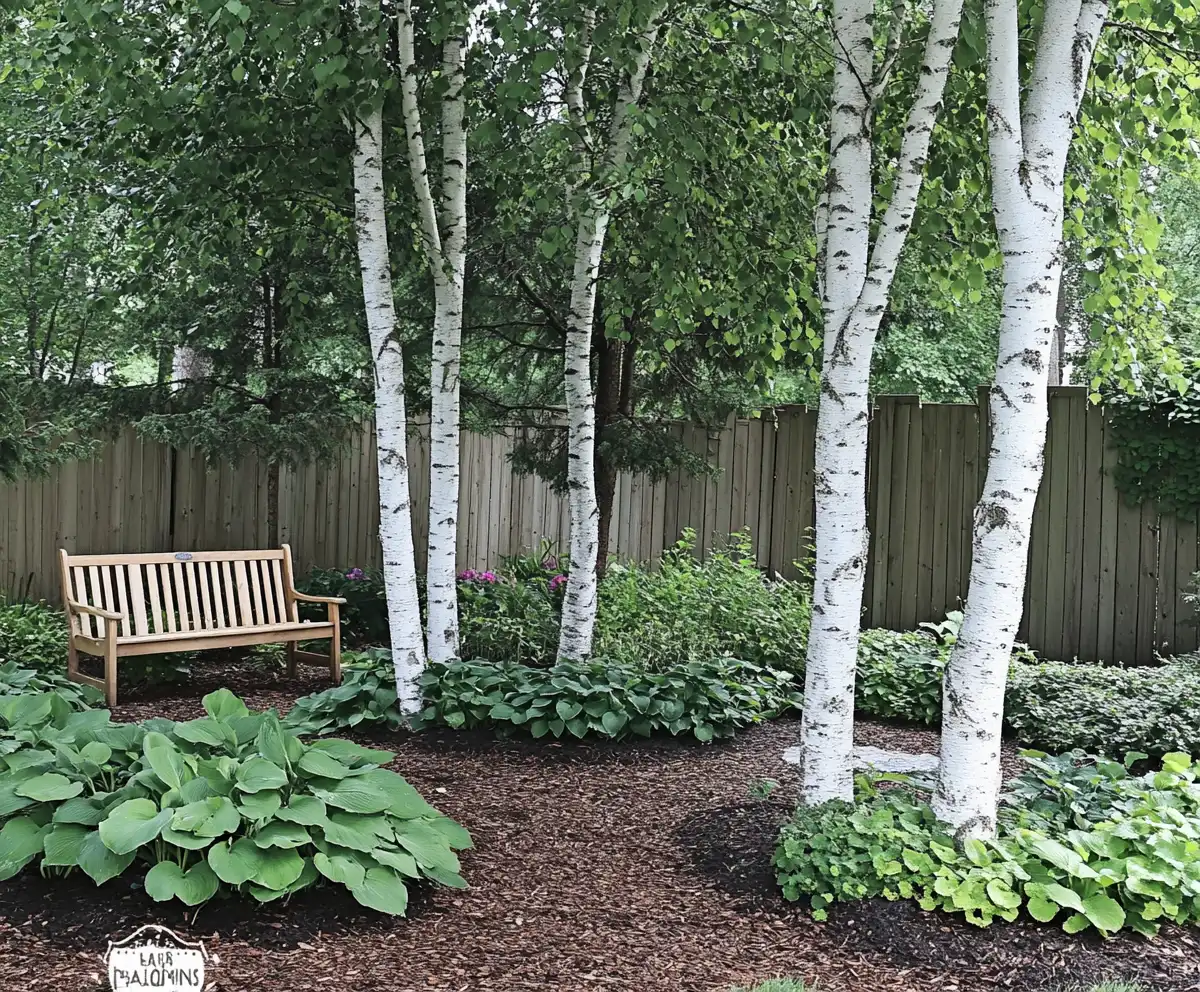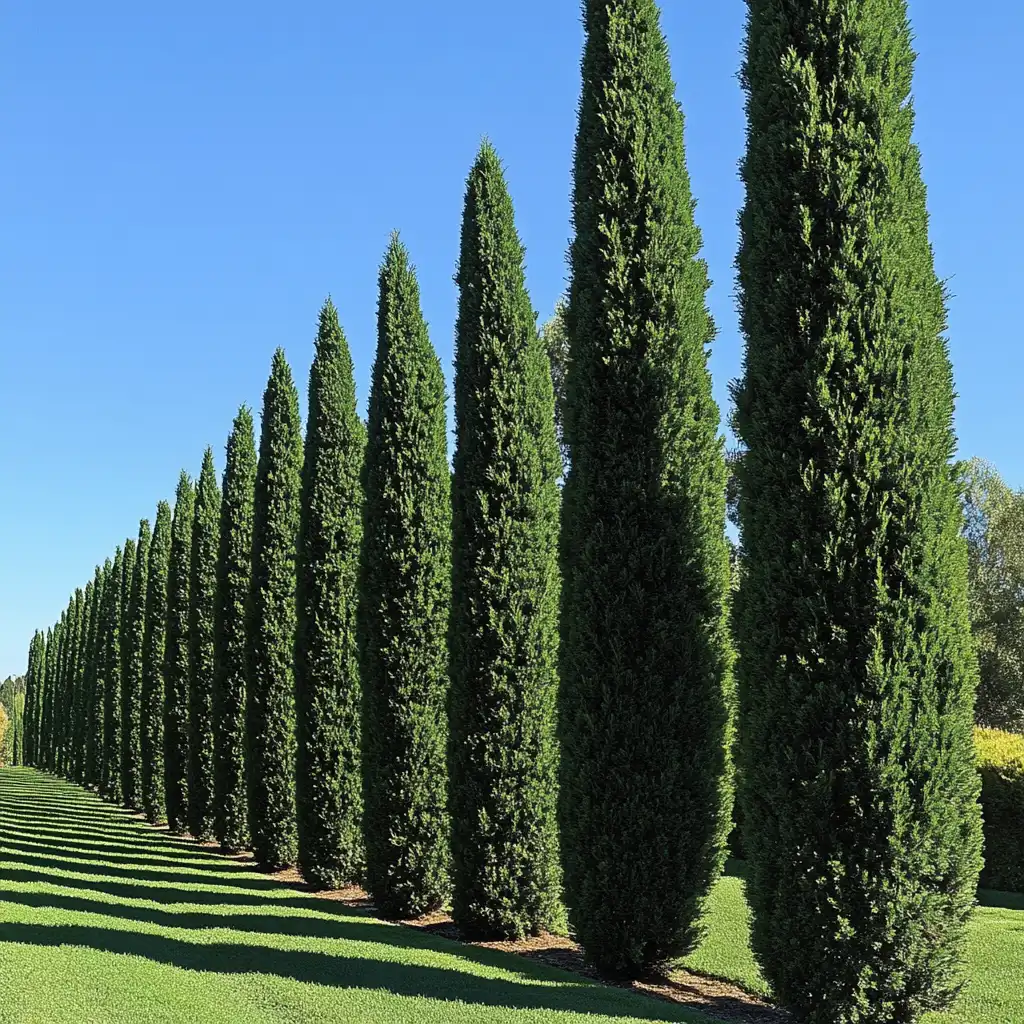When we first moved into our cozy suburban home, we didn’t anticipate how much we’d crave privacy. Morning chats with neighbors were pleasant, but the lack of a secluded space to sip coffee or unwind made our backyard feel more like a shared courtyard than a personal retreat. That’s when we discovered the power of privacy trees along fence lines — a simple, natural solution that changed everything.
Rather than pouring money into tall fences or stark hardscaping, we chose to grow a green boundary. Planting fast-growing privacy trees along our fence gave us shade, year-round beauty, and a peaceful atmosphere that no wood panel could replicate. Within just a couple of seasons, our open lawn became a lush sanctuary — a leafy escape that felt worlds away from the next-door driveway.
If you’re seeking an affordable and beautiful way to create privacy in your backyard, choosing the right privacy trees along fence lines could be your ideal solution. Whether you’re pairing them with flower garden ideas or designing a cohesive outdoor space, these trees offer long-term comfort and curb appeal that grows better with time.
🌲 15 Fast-Growing Privacy Trees to Plant Along Your Fence
These fast-growing trees can help you establish a natural barrier in less time than you’d think. Whether you’re shielding your patio from nosy neighbors or simply creating a serene space, the following options are ideal privacy trees along fence lines.
1. Leyland Cypress
Growth Rate: 3–5 feet/year
Why It’s Great: If you want a solid, towering screen in record time, Leyland Cypress is your go-to. Its dense, evergreen foliage offers full coverage throughout the year, making it one of the most popular choices for privacy. This tree thrives in full sun and handles pruning well — perfect for shaping a green wall along the fence.
2. Thuja ‘Green Giant’
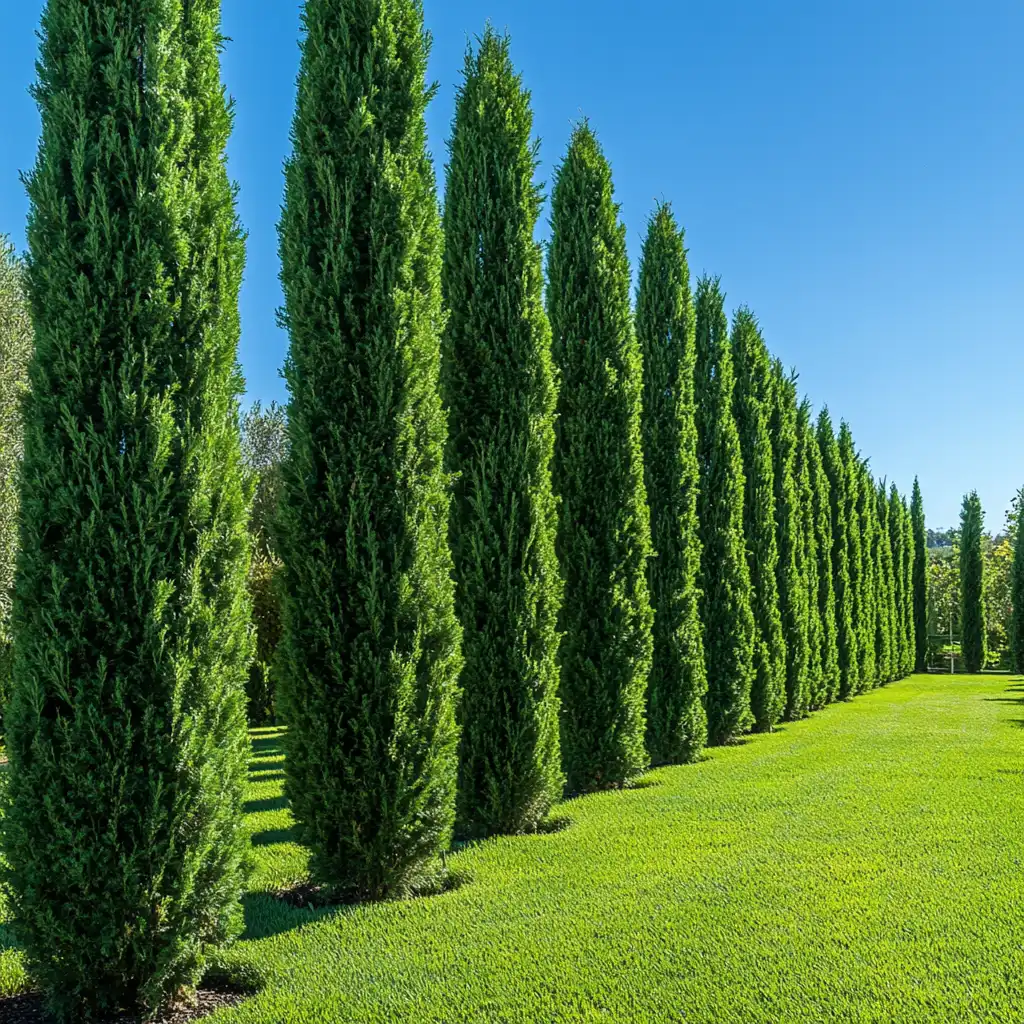
Growth Rate: 3–5 feet/year
Why It’s Great: Similar to Leyland Cypress but even lower maintenance. The ‘Green Giant’ is lush, resilient, and resists pests and diseases. It holds its deep green color even through winter, making it ideal for year-round privacy trees along fence rows.
3. Eastern Red Cedar
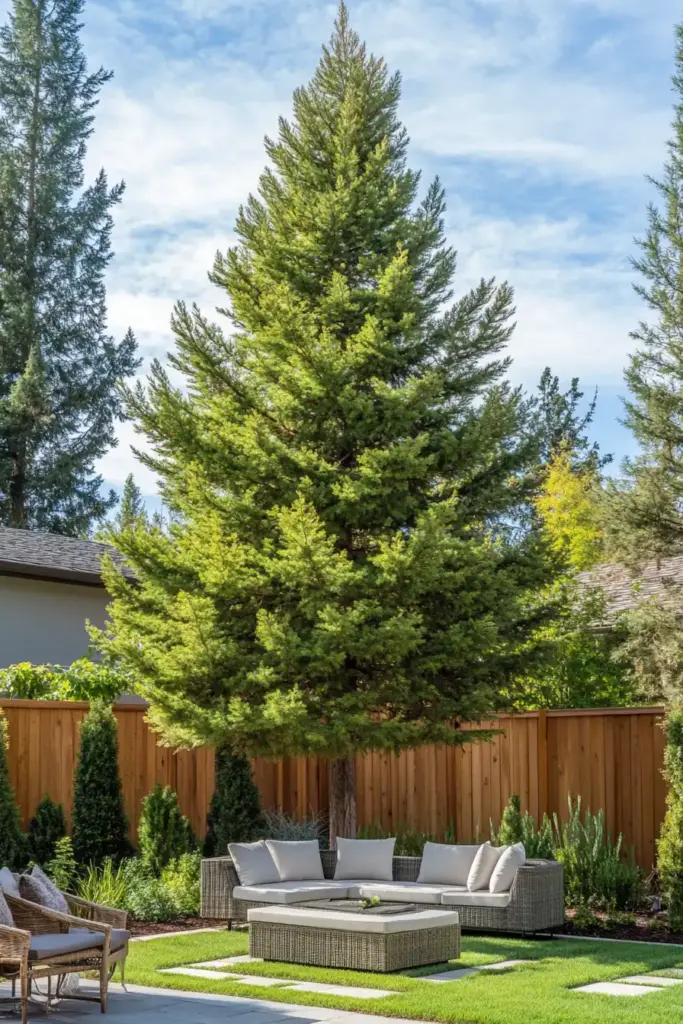
Growth Rate: 1–2 feet/year
Why It’s Great: A slower grower, but tough as nails. This native evergreen is drought-resistant, tolerates poor soil, and has a beautiful silvery-green hue. Ideal if you want a hardy tree that asks for little while delivering lasting privacy.
4. Arborvitae ‘Emerald Green’
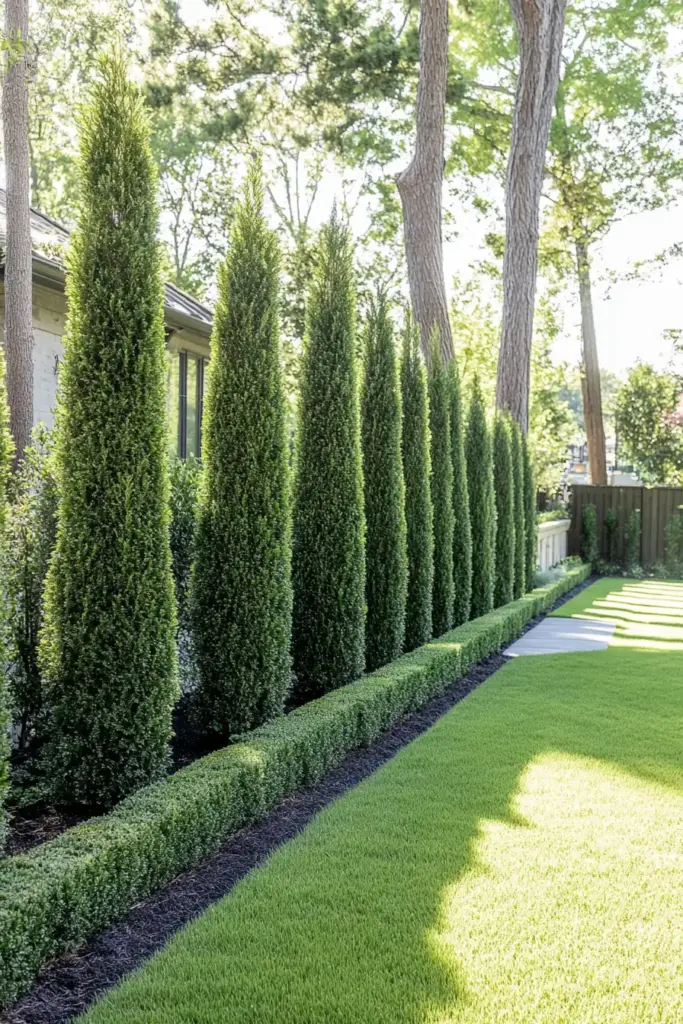
Growth Rate: 1–2 feet/year
Why It’s Great: Perfect for smaller properties or narrow side yards. This compact, upright evergreen forms a tidy row that’s both elegant and functional. It’s one of the most space-efficient privacy trees along fence spaces.
5. Clumping Bamboo
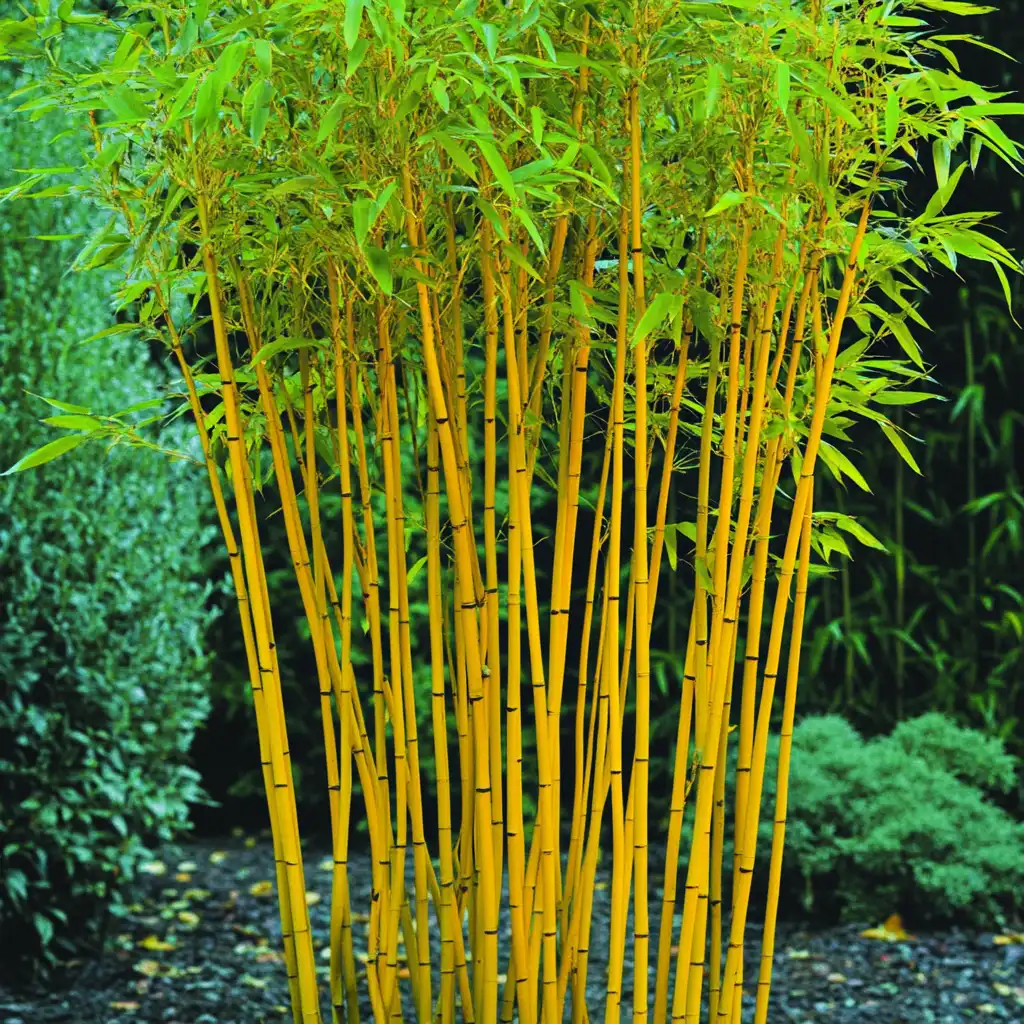
Growth Rate: 3–5 feet/year
Why It’s Great: Looking for a non-traditional option? Clumping bamboo gives your yard a modern, tropical vibe while creating dense coverage quickly. Unlike its running cousin, clumping bamboo stays in place — ideal for creating privacy without worrying about invasiveness.
6. Hybrid Poplar
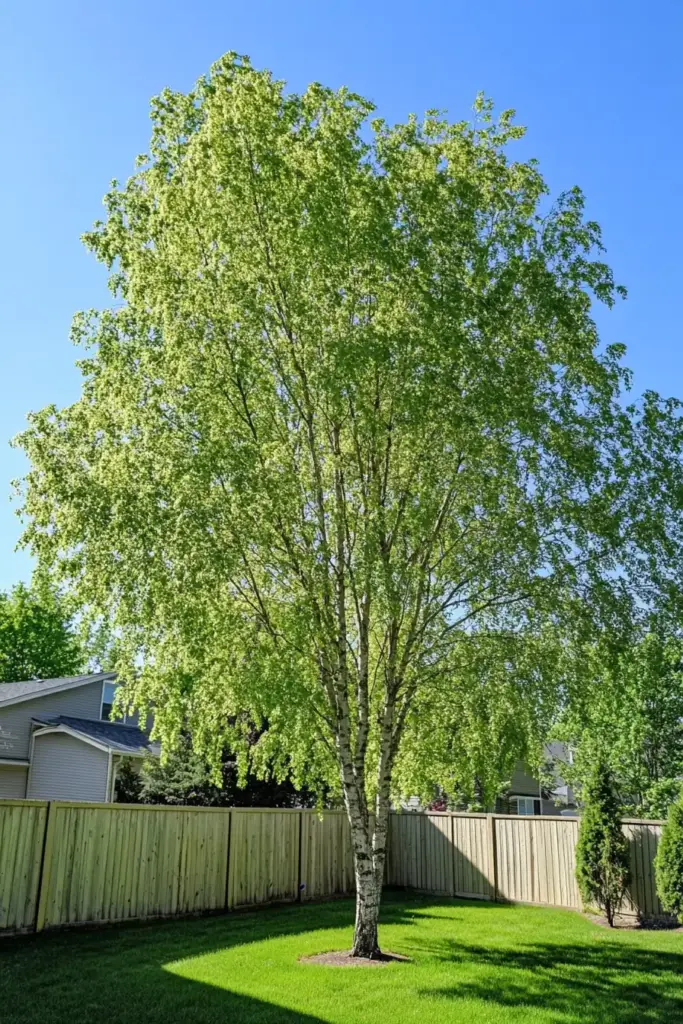
Growth Rate: 5–8 feet/year
Why It’s Great: Incredibly fast-growing, this tree shoots up in no time. While its lifespan is relatively short (20–30 years), it serves as a fantastic temporary solution while more permanent trees mature behind it.
7. Silver Maple
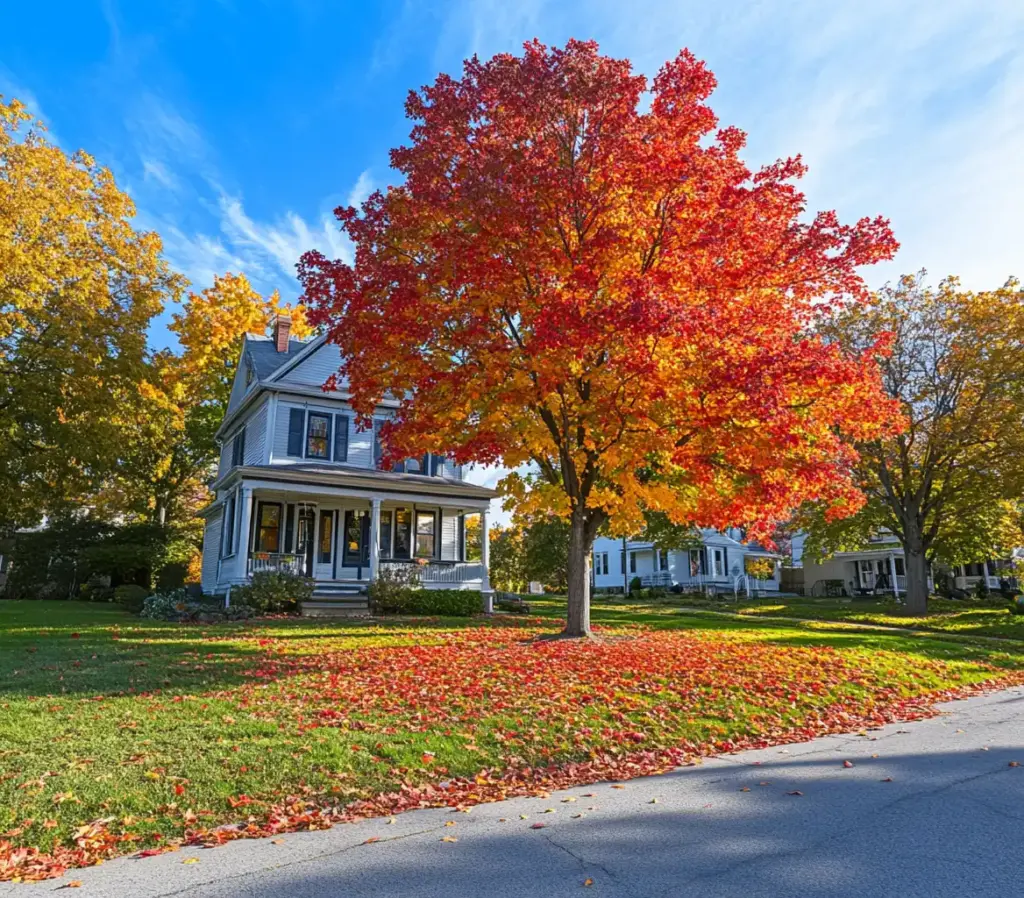
Growth Rate: 2–3 feet/year
Why It’s Great: Large leaves, rapid growth, and a wide canopy make this tree an excellent choice for overhead privacy. Just be cautious of its root spread—give it plenty of room to grow away from your fence line.
8. Tulip Tree
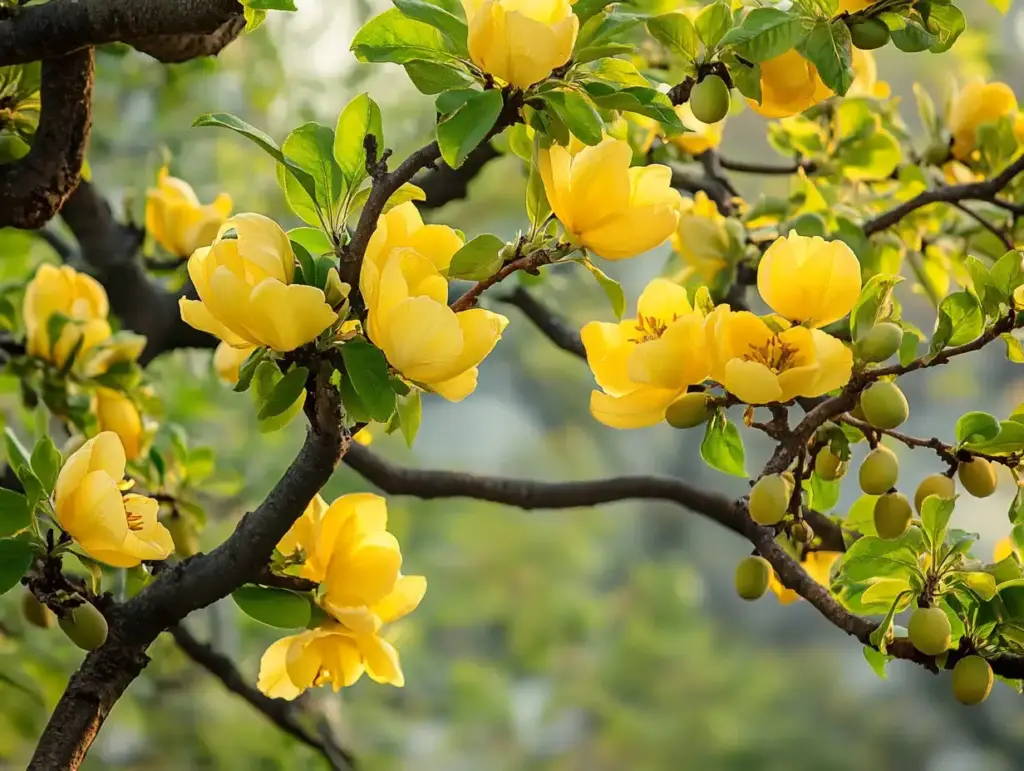
Growth Rate: 2–3 feet/year
Why It’s Great: Also known as Tulip Poplar, this tree offers vertical growth and stunning spring flowers. It’s a show-stopper that adds both aesthetic value and seclusion when planted as privacy trees along fence borders.
9. Willow Hybrid
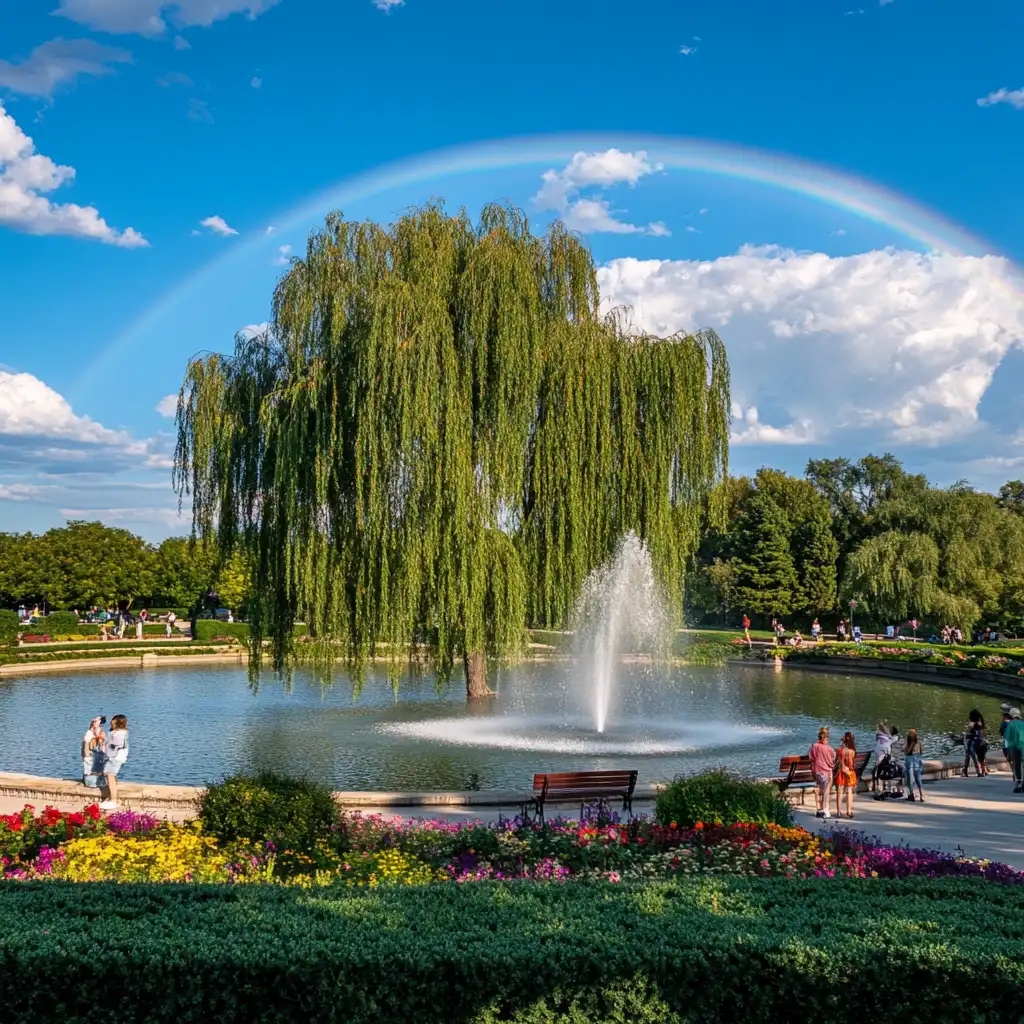
Growth Rate: 6–10 feet/year
Why It’s Great: One of the fastest growers on this list, Willow Hybrids are unbeatable for speed. They’re ideal for large properties or spots where a tall, thick hedge is needed quickly. Keep them well-watered during the first year to ensure strong establishment.
10. Dawn Redwood
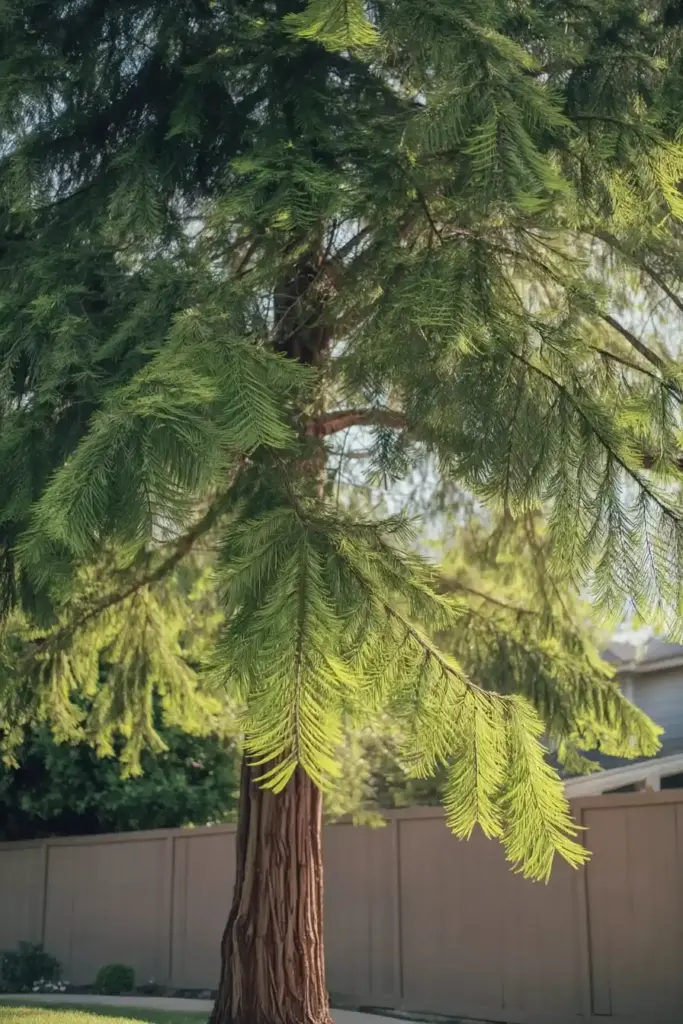
Growth Rate: 3–5 feet/year
Why It’s Great: Though deciduous, this ancient tree grows fast and tall with soft, feather-like foliage. Its upright form makes it a stately addition for long fence lines needing vertical privacy.
11. River Birch
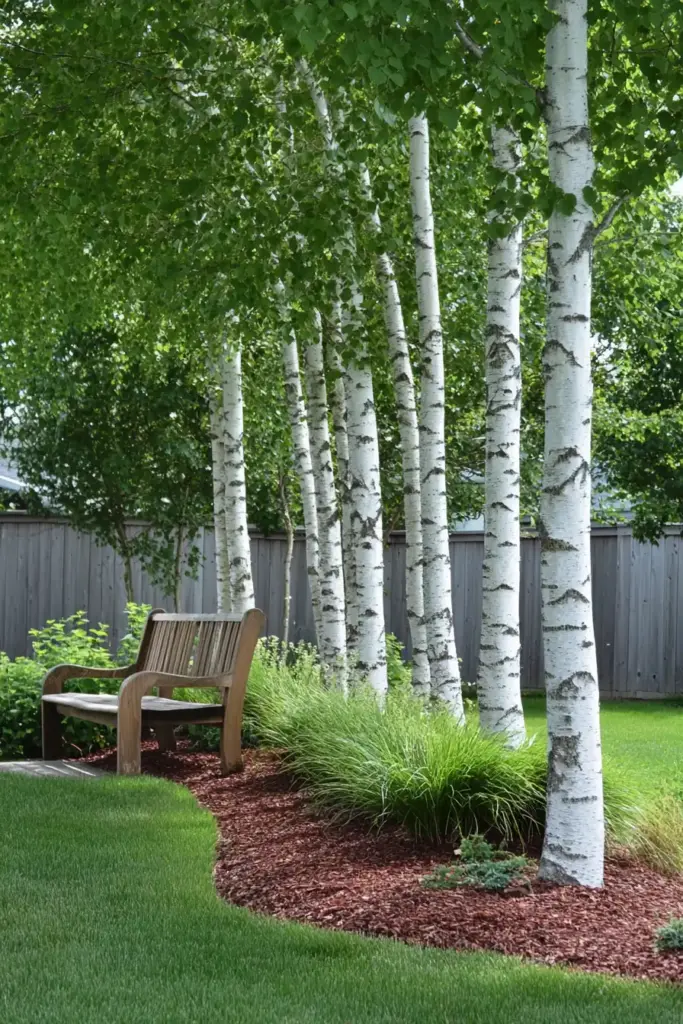
Growth Rate: 2–3 feet/year
Why It’s Great: Thrives in moist conditions and offers unique ornamental bark that peels attractively. It grows well in low-lying or damp areas where other trees might struggle.
12. Cold-Hardy Eucalyptus
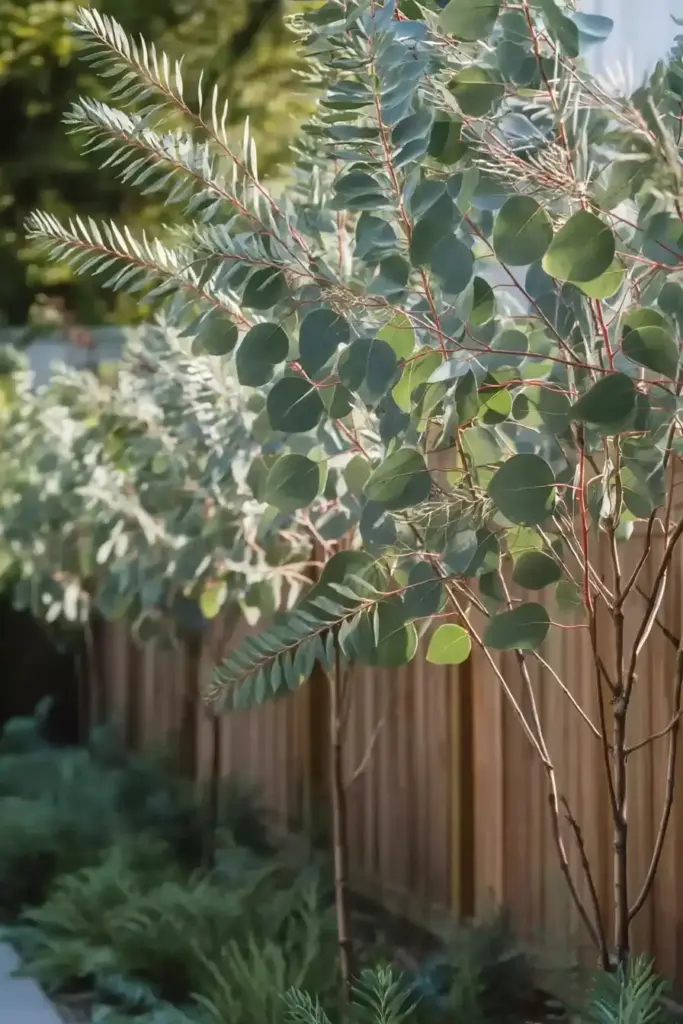
Growth Rate: 6+ feet/year
Why It’s Great: Fast and fragrant, this tree brings an airy canopy and pleasant aroma to your garden. Choose a variety that’s suited to your zone, and enjoy year-round greenery where climate permits.
13. Italian Cypress
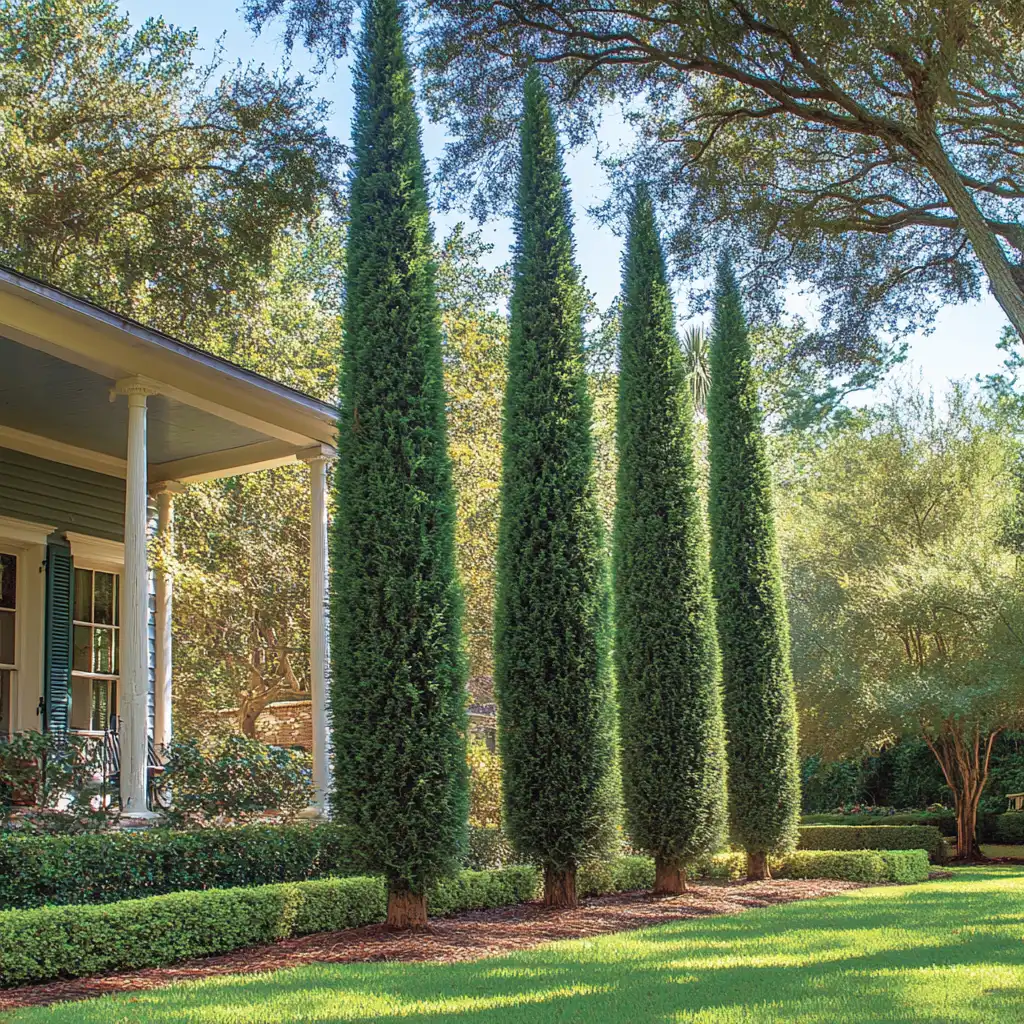
Growth Rate: 2–3 feet/year
Why It’s Great: Tall and slim, these Mediterranean beauties are perfect for tight rows. Their vertical form provides effective screening while conserving ground space — excellent privacy trees along fence in narrow yards.
14. Red Maple
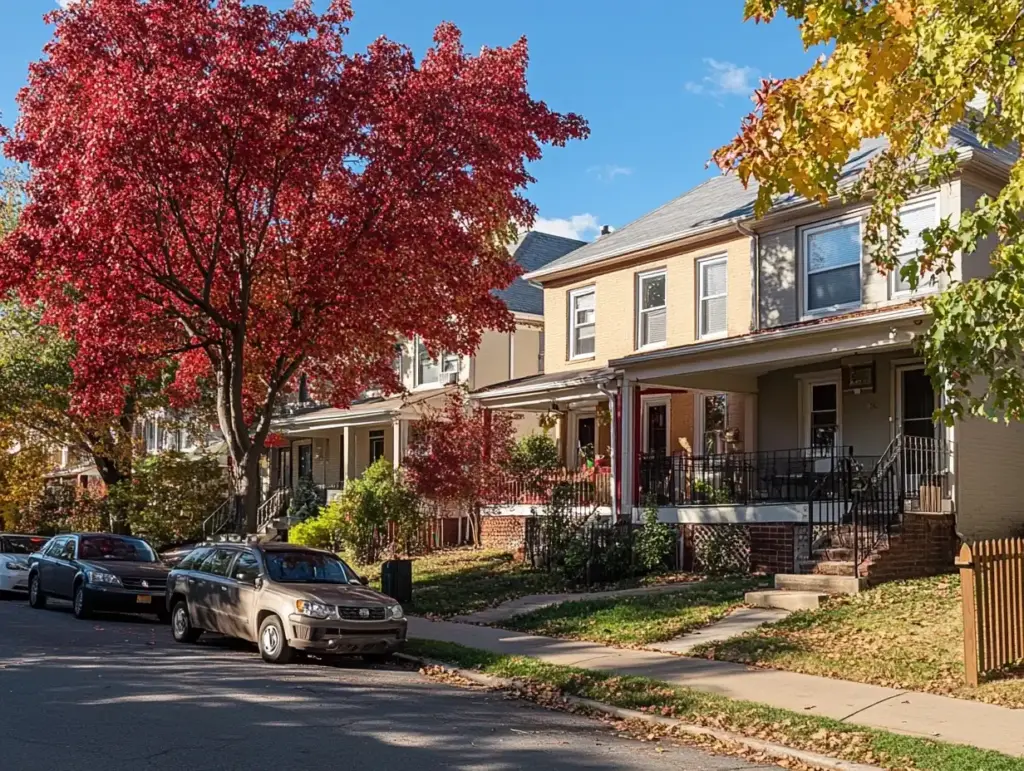
Growth Rate: 2–3 feet/year
Why It’s Great: Provides vibrant seasonal color while also acting as a fast-growing privacy solution. These trees mature into shade providers and are known for their stunning fall foliage.
15. Cryptomeria ‘Radicans’

Growth Rate: 3–4 feet/year
Why It’s Great: This evergreen offers soft texture and full coverage. It performs well in various climates and doesn’t look as heavy or formal as other evergreens, making it a great option for relaxed, natural fences.
That wraps up the list of the 15 best privacy trees along fence lines. When planted with care, these trees will not only boost your yard’s privacy but also enhance its beauty and biodiversity.
🌿 Expert Tips for Choosing and Planting Privacy Trees Along Fence Lines
Selecting the right privacy trees along fence lines isn’t just about picking the fastest grower. To create a successful, lasting screen, you’ll need to consider your space, soil, and long-term maintenance. Here’s what experienced gardeners (and your future self) want you to keep in mind:
1. Match the Tree to Your Space
Before you fall in love with a specific tree, look at the mature height and width. Will it tower over your roofline? Will its roots threaten underground pipes or nearby foundations? Choosing a tree that fits your available space will prevent future headaches and costly removals.
Pro Tip: Use columnar or upright varieties like Arborvitae or Italian Cypress for narrow yards.
2. Water Early and Often (Then Ease Off)
Even drought-tolerant trees need a strong start. During the first growing season, make sure your new plantings receive consistent, deep watering to encourage healthy root systems. After they’re established, you can reduce watering frequency based on climate and species.
3. Mix Fast and Slow Growers for Layered Coverage
Hybrid Poplar and Willow Hybrid might give you fast coverage, but they won’t last as long as Red Maple or Thuja. For the best of both worlds, plant fast growers in front of slower ones. As the longer-living trees mature, the fast ones can be pruned or removed.
4. Plan for Maintenance
Trees don’t stop at the height you want them to. Some fast growers can shoot up past 40 feet and start shading areas unintentionally or invading gutters. Regular trimming and shaping will keep your privacy trees along fence lines manageable and healthy.
Tip: Look for low-maintenance species if you want to avoid regular pruning.
5. Consult Your Local Nursery or Extension Office
Your climate zone, soil type, and rainfall will affect how each tree performs. Local nurseries often carry native or well-adapted varieties that outshine generic big-box selections. They’ll also help you avoid invasive species that could spread into neighboring properties.
6. Don’t Forget Aesthetic Appeal
Privacy is important, but your landscape should also be a place you love looking at. Mix textures (like soft Cryptomeria with sleek Bamboo) or seasonal colors (like Red Maple) to add visual interest while maintaining privacy.
These tips will help you build a privacy solution that’s not just fast, but also sustainable, attractive, and easy to live with. Whether you’re tucking a few trees into a small corner or lining an entire fence, thoughtful planning makes all the difference.
❓ Frequently Asked Questions: Privacy Trees Along Fence Lines
1. What are the best privacy trees to plant along a fence?
The best privacy trees along fence lines are typically fast-growing evergreens like Leyland Cypress, Thuja ‘Green Giant,’ and Arborvitae ‘Emerald Green.’ These varieties offer year-round coverage and adapt well to most suburban yards. For homeowners wanting a unique look, consider adding clumping bamboo for a tropical feel or Red Maple for vibrant seasonal color. For inspiration, check out our guide to the most beautiful plants for fence line privacy.
2. How close can I plant privacy trees to a fence?
When planting privacy trees along fence lines, spacing is crucial for healthy growth. Ideally, place trees at least 3 to 6 feet away from the fence, depending on the species’ mature width. This ensures good airflow, prevents overcrowding, and protects both your tree roots and any nearby structures. Planting too close can lead to maintenance headaches and stunted growth.
3. Which privacy tree grows the fastest?
Willow Hybrid and Hybrid Poplar top the list for rapid growth — often shooting up 6 to 10 feet per year. These are excellent choices for creating quick privacy while slower-growing trees mature behind them. However, because they have shorter lifespans, it’s smart to mix them with longer-living trees like Thuja or Red Maple. Learn how to layer plantings effectively in our easy backyard landscaping ideas.
4. Can I plant trees instead of building a privacy fence?
Absolutely! Planting privacy trees along fence lines is an eco-friendly and visually pleasing alternative to installing a traditional fence. Trees provide more than just seclusion — they absorb noise, improve air quality, and add natural beauty. Over time, your tree barrier becomes an integral part of your outdoor space, unlike static fencing which may require regular repairs or replacement.
5. Are there privacy trees that won’t grow too tall?
Yes! If you’re working with a compact space, you can still enjoy privacy trees along fence borders without the towering height. Arborvitae ‘Emerald Green’ and Italian Cypress are ideal for narrow yards thanks to their upright, narrow growth habit. They provide dense coverage without overwhelming nearby structures — perfect for side yards or tight suburban lots.
6. Do privacy trees require a lot of maintenance?
Most privacy trees along fence lines are surprisingly low-maintenance once established. That said, fast growers like Willow Hybrid may require occasional pruning to manage height and shape. Deep watering during the first year is essential to establish a healthy root system. After that, a seasonal trim and mulch refresh are typically all that’s needed. For more tips on low-maintenance options, check out our article on full sun perennials that thrive effortlessly.
7. Will privacy trees grow well in pots or containers?
Only select varieties of privacy trees along fence areas can thrive in containers. Compact options like dwarf Arborvitae or clumping bamboo are good candidates. However, most fast-growing privacy trees need in-ground planting for long-term health due to their deep root systems and size potential. Container-grown trees may also need more frequent watering and pruning to stay healthy and attractive.
🌼 Conclusion: Privacy, Naturally Grown
Fences might block a neighbor’s gaze, but only nature can offer privacy that breathes. Privacy trees along fence lines do more than hide—they soften, shelter, and soothe. These living screens add seasonal color, attract birds and pollinators, and evolve with your landscape. With the right selection of privacy trees along fence, you’re not simply installing a barrier—you’re nurturing a personal retreat filled with shade, beauty, and quiet. Whether you’re drawn to the rapid growth of Hybrid Poplar, the graceful blooms of Tulip Trees, or the tidy vertical growth of Emerald Green Arborvitae, each tree type enhances your yard in its own distinct way.
Before planting, take a slow stroll through your space. How much sun does it get? Is your soil rich or sandy? Do you want year-round greenery or seasonal variety? Your answers will guide your choices. Many gardeners find that combining fast-growing options with slower, longer-living trees creates a dynamic landscape that matures gracefully over time. And if you’re looking to layer your design with color and texture, pairing these trees with vibrant flower bed ideas for your front yard can amplify the beauty while maintaining function.
Ultimately, planting privacy trees along fence lines is one of the most rewarding ways to turn an exposed backyard into a thriving, tranquil escape. With just a little planning, your yard can grow into a living oasis—no pickets, panels, or pricey barriers required.

